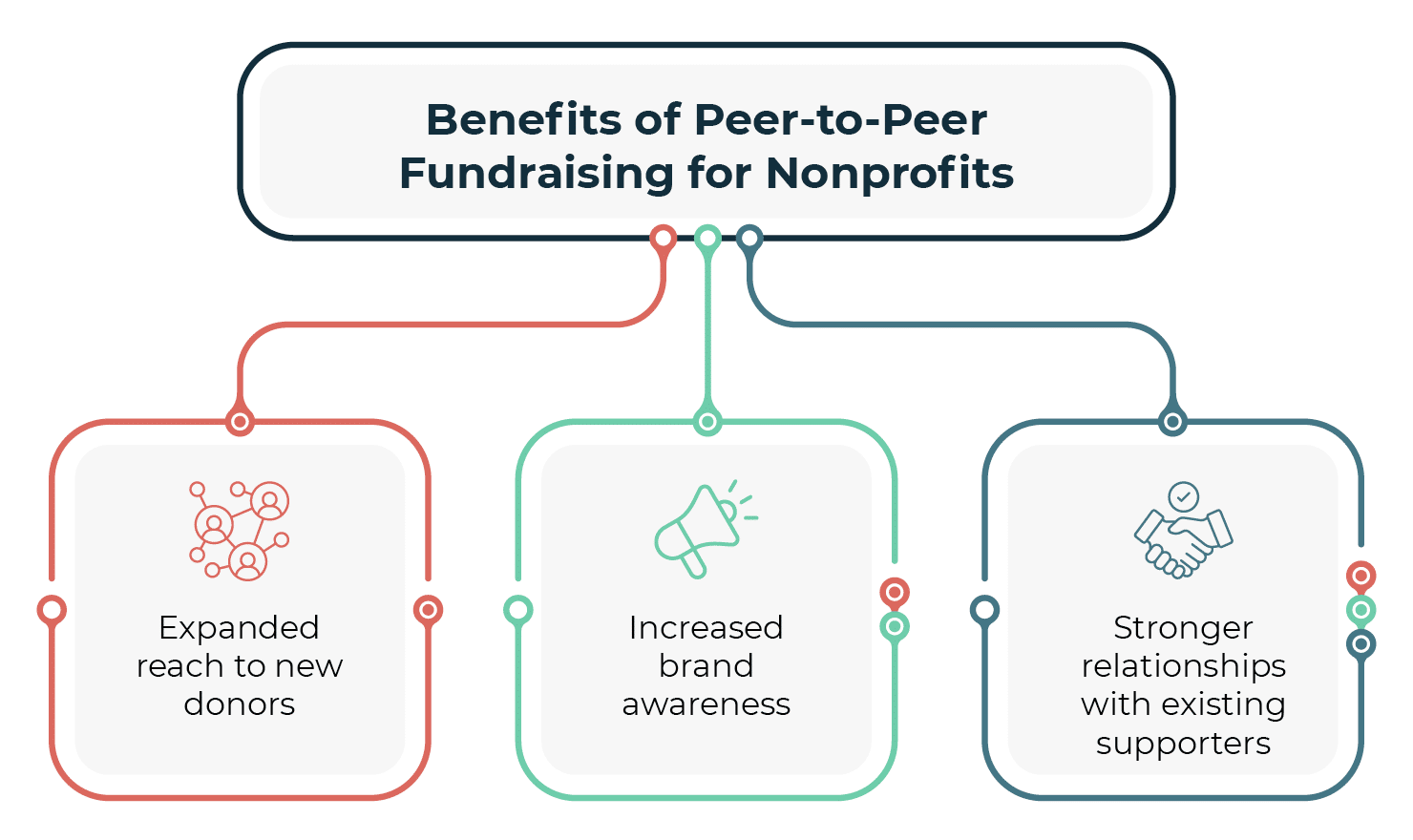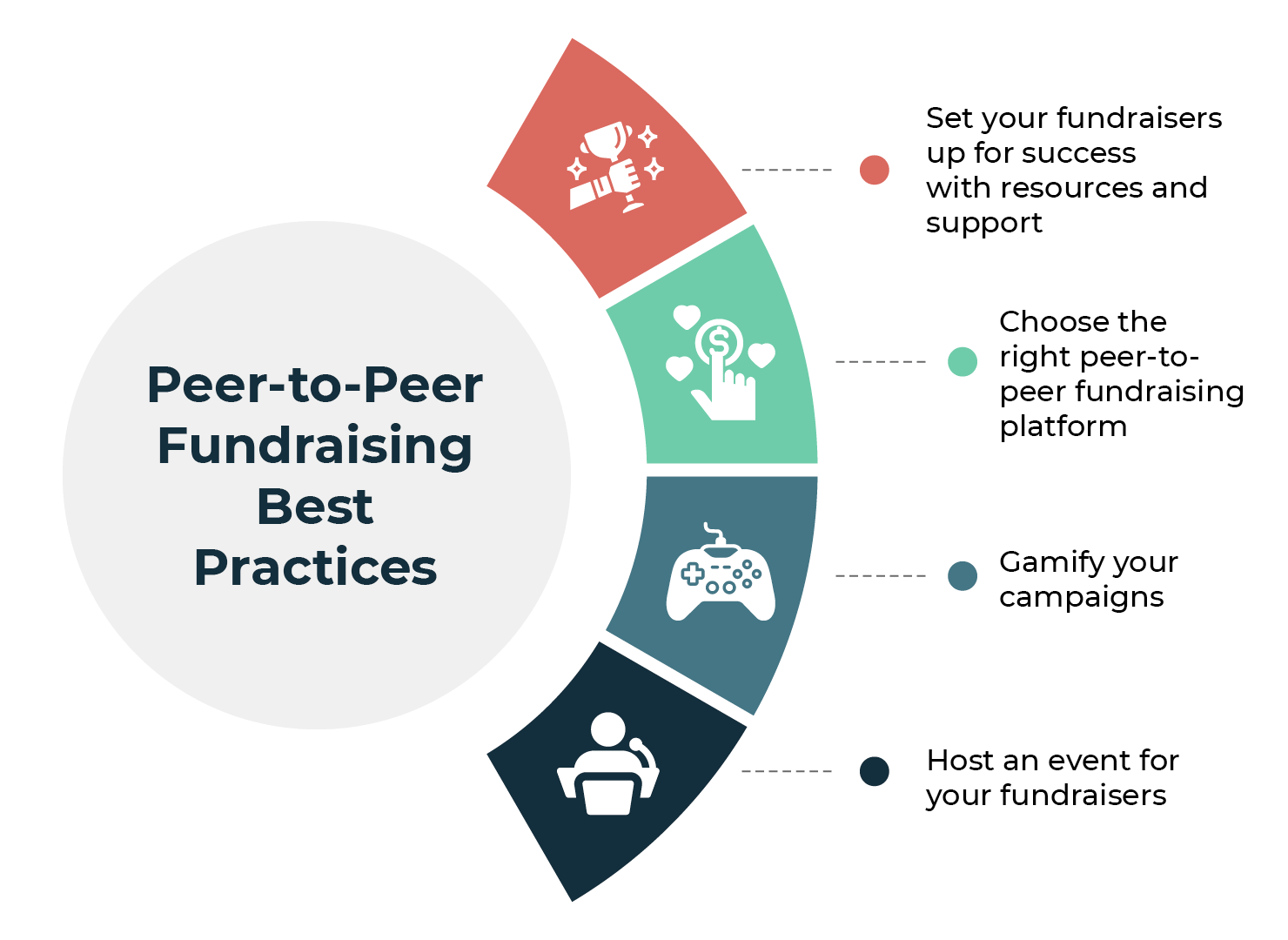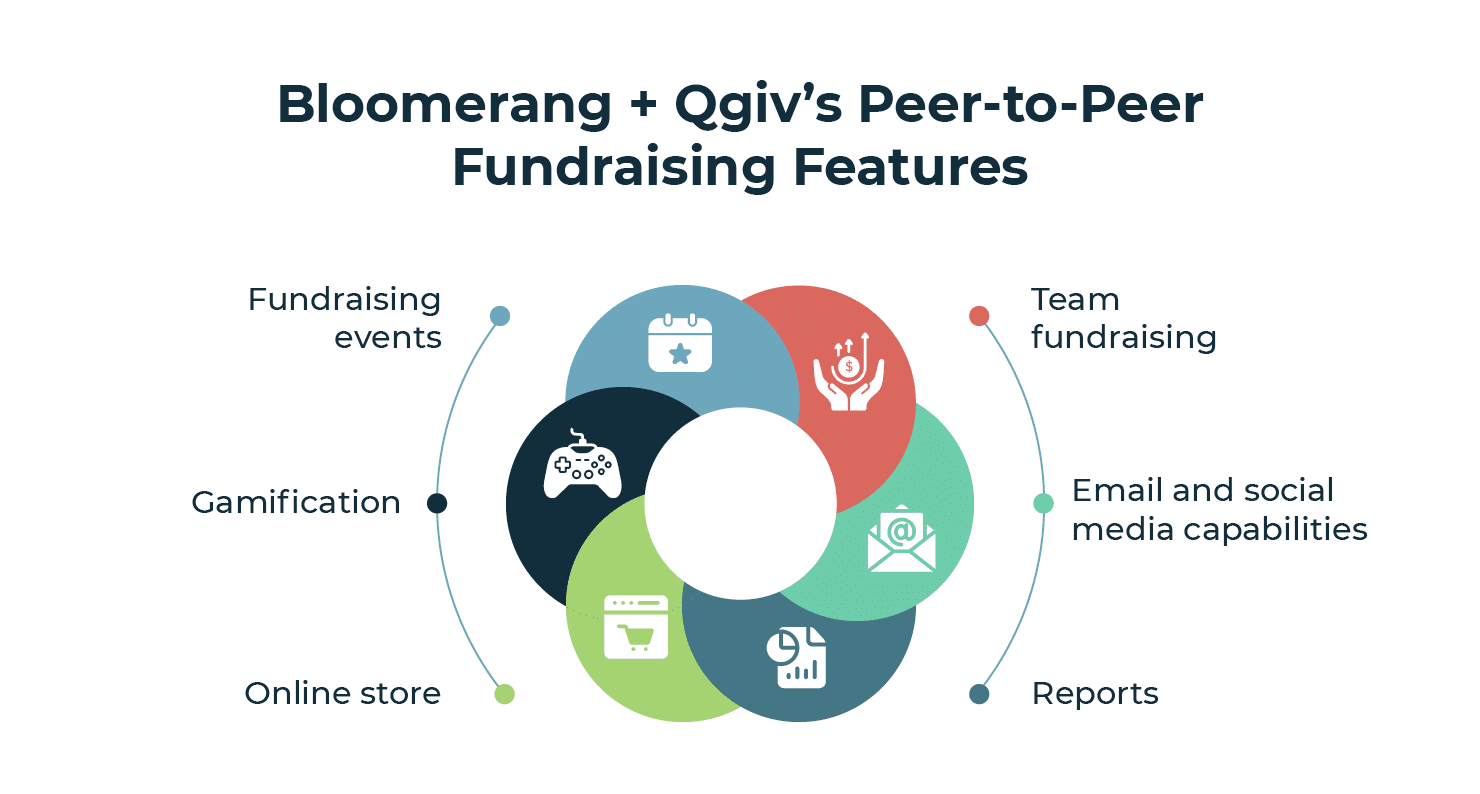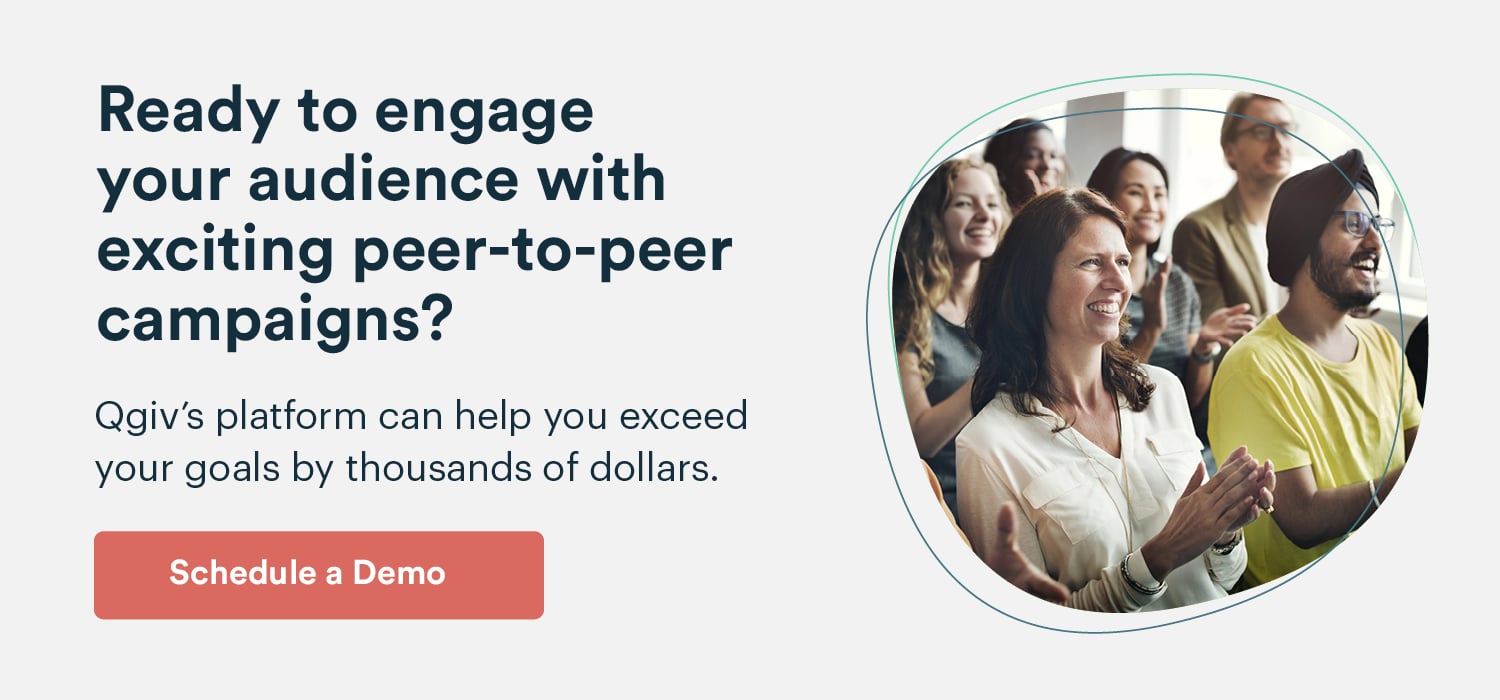Peer-to-Peer Fundraising 101: Expert Tips for Your Campaigns

Peer-to-peer fundraising continues to drive incredible results for nonprofit organizations. The top 30 peer-to-peer fundraising programs grew 3.2% in 2023, reaching $1.1 billion in collective revenue. This represents a 15.6% increase over 2022.
This guide will explore what makes peer-to-peer fundraising so successful, along with best practices for optimizing your approach. We’ll cover:
- What is peer-to-peer fundraising?
- How does peer-to-peer fundraising benefit nonprofits?
- Peer-to-peer fundraising campaign ideas
- Best practices to optimize your peer-to-peer fundraisers
- How Bloomerang + Qgiv can support your peer-to-peer fundraising efforts
If you’re looking for a unique way to engage supporters for the long term, peer-to-peer fundraising is a great place to start. Let’s dive into what this fundraising technique entails.
What is peer-to-peer fundraising?
Peer-to-peer fundraising is when individuals organize personal campaigns to collect donations from their peers on behalf of a nonprofit. These fundraisers may include asking for donations via an online donation page, throwing occasion-specific fundraisers (like birthday fundraisers), and participating in events like team fun runs. Peer-to-peer fundraising can also be referred to as P2P or social fundraising.
How does peer-to-peer fundraising benefit nonprofits?

Many nonprofits turn to this fundraising method because it allows them to:
- Expand their reach past their own contact lists and into supporters’ networks. 92% of consumers trust recommendations from people they know. Donors have direct access to friends, family members, coworkers, and other peers who may have never heard of your organization. Therefore, when current supporters vouch for your organization, they can more effectively make your case to new audiences.
- Increase brand awareness. Those advocating and soliciting donations for your cause do more than just raise money on behalf of your organization; their vocal, public support increases brand awareness for your mission. 64% of consumers need to hear claims from a brand three to five times before they believe them. When peer-to-peer participants share fundraising materials with your organization’s logo, colors, and imagery, they help reinforce brand recognition for your nonprofit.
- Strengthen relationships with existing supporters. Peer-to-peer fundraising offers a unique opportunity to engage top donors and volunteers in a prominent fundraising role. Research shows that peer-to-peer fundraising campaigns can help retain up to 50% of donors.
Peer-to-peer fundraising empowers supporters to take an active fundraising role. Sharing what your cause means to them with a wider audience can make their involvement much more meaningful.
Peer-to-peer fundraising campaign ideas
Spark your creativity with these peer-to-peer fundraising campaign ideas to engage your audience:
5K race
Athletic events are a great way to get people actively involved in fundraising, especially 5K races. 5Ks are the most popular road race in the United States.
Create a course at a local trail or road that you can close off to vehicle traffic. Offer prizes for top finishers in each age bracket. Encourage peer-to-peer fundraising by requiring participants to raise funds to cover a specific entry fee before they can participate.
Make the event more accessible by including kid and family-friendly events like a kid’s one-mile dash or a family fun walk.
Walk-a-thon
A walk-a-thon is another engaging athletic event that encourages participants to walk as many miles or laps as they can. Ask participants to gather pledges from their family and friends before the event. These pledges will correlate to donations earned for your nonprofit for every mile or lap participants walk.
Polar plunge
A polar plunge challenges supporters to withstand freezing temperatures to earn funding for your mission.
Require participants to fundraise before your event. Allow them to choose their own fundraising goal, or require a set goal for all participants.
After participants reach their goals, your event will involve them jumping into a cold body of water, whether a pool, lake, pond, or ocean. Add excitement to your event with a live DJ, emcee, and refreshments, including plenty of warm beverages.
Bake sale
Bake sales have been a go-to fundraising event for as long as people have been raising money. However, you can make your event stand out by having attendees “vote” on their favorite treat by donating to the campaign of the baker who made it. Encourage additional donations by selling beverages and merchandise at the event.
Holiday party
People running peer-to-peer campaigns can easily turn their annual holiday party into a fundraising event. Hosts can include the campaign information on the invite and send additional communications as the event approaches. They can also acknowledge outstanding donors at the party.
This can be a great option for corporate holiday parties, fostering greater ties between businesses and nonprofits in their area.
Merchandise campaign
In a merchandise campaign, supporters can promote and sell branded merchandise on behalf of your nonprofit. Your organization can design merchandise and create a central campaign page. Then, supporters can create their own fundraising pages connected to the main hub.
Giving day
A giving day is a concentrated fundraising period that only lasts 24 hours. The most well-known giving day is GivingTuesday, which raised $3.1 billion in donations in 2023.
Your nonprofit can create a GivingTuesday campaign, as well as a unique giving day campaign on a date of your choice. During the giving day, participants will share personalized donation pages to spread your nonprofit’s message and raise funds.
Virtual challenge
A virtual challenge is a peer-to-peer fundraising opportunity that takes place online, typically via social media. You can challenge your supporters to complete a certain task or activity. Their family members and friends can donate to support their efforts. Examples of virtual challenges include the ALS Ice Bucket Challenge or Movember.
Best practices to optimize your peer-to-peer fundraisers
Creating an effective peer-to-peer fundraising approach starts with equipping your supporters with the tools, resources, and inspiration they need to reach success. Use these best practices to start off on the right foot:

Set your fundraisers up for success
Fundraisers will be eager to get to work on your behalf, but they may need some tools and support along the way. Set your fundraisers up for success by providing them with materials like:
- Pre-written copy to include on their fundraising pages. This copy can be something as simple as “My name is ______, and I’m fundraising on behalf of [your organization’s name] to support their [project or program the donations will go toward]. I’ve been involved with this organization for [number of years] because of [personal connection to your cause]. Would you consider supporting me so I can reach my goal?”
- Images and videos to incorporate on their fundraising pages. These can be images from fundraising events, volunteer opportunities, or other forms of community outreach. Make sure the images are authentic and genuine (definitely don’t include stock photos!). You can also encourage supporters to add their own photos of themselves participating in your organization’s events or volunteer opportunities.
- Fundraising letter templates. Provide templates to help fundraisers reach out to friends and family via email, text, or social media. You can also provide fundraising scripts for participants who want to reach out via phone calls.
You can also create a group chat for fundraisers using platforms like Facebook, GroupMe, or Slack. Participants can share tips, fundraising wins, milestones, and words of encouragement with one another. This is a great way to foster a sense of community among your fundraisers, making the experience more engaging and meaningful.
Choose the right peer-to-peer fundraising platform
Successful peer-to-peer campaigns require an effective peer-to-peer fundraising platform. Here are some features to look for to find the peer-to-peer fundraising platform that’s best for you:
- A central campaign page. You’ll use the central campaign page to track your overall campaign progress. You can also use this page to showcase the leaderboard of top fundraisers, track overall donations, and communicate with fundraisers as a group.
- Individual fundraising pages. Fundraisers will use individual fundraising pages to share updates, upload pictures and videos, and post content to their social media platforms.
- Communication features. In addition to the central campaign page, you’ll need ways to communicate with individual participants. Through your peer-to-peer fundraising platform, you should be able to send direct messages, share documents, and receive responses from fundraisers.
- Reporting tools. Your peer-to-peer platform should enable you to track success metrics for your campaigns, including total donations, event registrations, merchandise sales, donor participation rates, and more.
Explore our list of top peer-to-peer fundraising platforms to compare features, pricing, and other considerations and find the right tool for your needs.
Gamify your campaigns
Add an element of friendly competition among fundraisers using gamification features. These may include:
- Fundraising thermometers to track total donations raised by each participating fundraiser
- Fundraising commitments to challenge fundraisers to reach personal goals
- Badges to mark certain milestones, such as raising $100 in donations
- Leaderboards to easily identify your top fundraisers and reward your most successful participants at the end of the campaign
Acknowledge fundraisers who hit their campaign goals using gratitude emails. Personalize these emails with participants’ names and fundraising totals. Include details about how their hard work will positively impact your mission, such as through raising funds for your volunteer program or supporting your community outreach efforts.
Host an event for your fundraisers
Hosting kick-off and wrap-up events for your supporters is a great way to keep them motivated and engaged:
- A kickoff event can build excitement, communicate important information, and equip fundraisers with useful materials.
- A wrap-up event can celebrate the campaign’s success and encourage fundraisers to participate again in the future.
Make your events more engaging by including food and drinks, raffle prizes, a live DJ or band, or other forms of entertainment. Recognize top fundraisers at your wrap-up event with special prizes or awards to show appreciation for their dedication and increase the chances that they’ll participate in another campaign.
How Bloomerang + Qgiv can support your peer-to-peer fundraising efforts
If you’re looking for a robust peer-to-peer fundraising platform that makes it simple for your supporters to tackle their own campaigns, Qgiv is the right platform for you. Qgiv facilitates exciting, easy fundraising, whether you’re hosting a 5K, walk-a-thon, merchandise fundraiser, or any other type of P2P event.
Qgiv’s comprehensive features are designed to empower your supporters and donors at every turn. This platform’s tools include:

- Fundraising events. Set up event pages in minutes with user-friendly drag-and-drop tools. Accept event registrations from any device with mobile-optimized signup forms.
- Team fundraising. Facilitate team fundraising with features to assign team captains, add a leaderboard, and set team recruitment and fundraising goals.
- Gamification. Inspire participants to reach their goals with badges, leaderboards, and contests.
- Email and social media capabilities. Help supporters spread the word about your campaign with integrated email marketing tools, social sharing widgets, and email and social post templates.
- Online store. Easily sell merchandise, track inventory, and process shipping to foster a reliable revenue stream.
- Reports. Track donations, event registrations, purchases, and participant activity. Identify trends and patterns to adjust your strategies as needed.
In addition, Bloomerang has partnered with Qgiv to help nonprofits not only host successful peer-to-peer fundraisers but also engage and retain donors for the long term. Bloomerang’s donor management platform automatically generates donor insights to engage with new supporters in personalized and meaningful ways. This functionality empowers your nonprofit to develop long-lasting relationships with donors who gave to your organization for the first time through a peer-to-peer fundraiser.
The bottom line
Peer-to-peer fundraising offers organizations increased exposure, and in turn, more donations. The tips in this guide will help you create a sustainable approach to peer-to-peer fundraising to generate a reliable new revenue stream for your organization.
Looking for more resources to support your peer-to-peer fundraising efforts? Start here:
- 14 Exceptional Nonprofit Peer-to-Peer Fundraising Platforms. Browse our roundup of top peer-to-peer fundraising platforms to find the right tool for your needs.
- 35 Exciting Peer-to-Peer Fundraising Ideas. Explore more peer-to-peer fundraising campaign ideas to inspire and engage your audience.
- A Guide to Donor Retention. Learn how to retain donors for the long haul with Bloomerang’s comprehensive donor retention guide.


